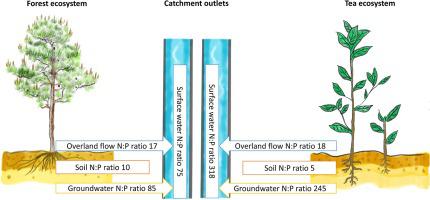Catena ( IF 6.2 ) Pub Date : 2020-06-09 , DOI: 10.1016/j.catena.2020.104740 Ji Liu , Yi Wang , Yong Li , Xinliang Liu , Yuexi Jiang , Yuxi Fu , Wenbo Jin , Jinshui Wu

|
An imbalanced surface water N:P (nitrogen:phosphorus) stoichiometric ratio degrades aquatic ecological and environmental functions. Although it is known that the N and P balance and hydrological processes in terrestrial ecosystems affect the surface water N:P ratio, how these factors regulate surface water N:P ratios remains unclear. Here, the N:P ratios in the nutrient budgets, soil, overland flow, groundwater, and surface water in two comparable tea and forest ecosystems and catchments were observed during the 2015–2017 period to link the hydrological processes with the surface water N:P ratio. The results suggested that although the N:P ratio of the nutrients released into the soil–water system was 1.84 times greater in the tea ecosystem than in the forest ecosystem, the soil N:P ratio (5 vs. 10 mol mol−1) was lower in the tea ecosystem, probably due to soil N and P decoupling processes associated with tea field establishment. The overland flow N:P ratios of the tea and forest ecosystems (30 and 28 mol mol−1, respectively) were similar and were mainly affected by surface hydrological processes. The groundwater N:P ratios were higher in the tea ecosystem than in the forest ecosystem (245 vs. 86 mol mol−1), indicating more intense soil N leaching than P leaching in the tea ecosystem. An ecosystem releases excessive N through the groundwater process, which contributes to the stability of the soil N:P ratio. It is estimated that the groundwater N:P ratio contributed more than the overland flow N:P ratio to the surface water N:P ratio (31.5–58.6% vs. 0.1–0.7%), which highlights the importance of the groundwater N:P ratio and subsurface hydrological processes for regulating the surface water N:P ratio in catchments. Therefore, to reduce the environmental risk posed by an unbalanced surface water N:P ratio in tea-growing regions, NP fertilizer application must be improved, and NP leaching should be minimized.
中文翻译:

生态系统N:P化学计量比通过地下水文过程确定集水区地表水N:P比
N:P(氮:磷)化学计量比不平衡会降低水生生态和环境功能。尽管已知陆地生态系统中的N和P平衡以及水文过程会影响地表水N:P比率,但这些因素如何调节地表水N:P比率仍不清楚。在这里,我们在2015-2017年期间观察到了两个可比的茶林生态系统和集水区的营养预算,土壤,陆地流动,地下水和地表水中的N:P比率,以将水文过程与地表水N联系起来: P比。结果表明,尽管茶水生态系统中释放到土壤-水系统中的养分的N:P比是森林生态系统中的1.84倍,但土壤N:P比(5对10 mol mol -1)在茶生态系统中较低,这可能是由于与茶田建立相关的土壤氮和磷解耦过程。茶和森林生态系统的陆流N:P比(分别为30和28 mol mol -1)相似,并且主要受地表水文过程的影响。茶生态系统中的地下水N:P比率高于森林生态系统中的地下水(N:P)(245对86 mol mol -1),表明茶生态系统中土壤氮的淋溶量比磷的淋溶量更大。生态系统通过地下水释放过量的氮,这有助于土壤氮磷比的稳定。据估计,地下水N:P比率对地表水N:P比率的贡献超过了地表水N:P比率(31.5–58.6%对0.1–0.7%),这突出了地下水N:P的重要性。 P比和地下水文过程,用于调节流域的地表水N:P比。因此,为减少茶叶种植地区地表水N:P比例不平衡带来的环境风险,必须改善NP肥料的施用,并尽量减少NP的淋溶。


























 京公网安备 11010802027423号
京公网安备 11010802027423号